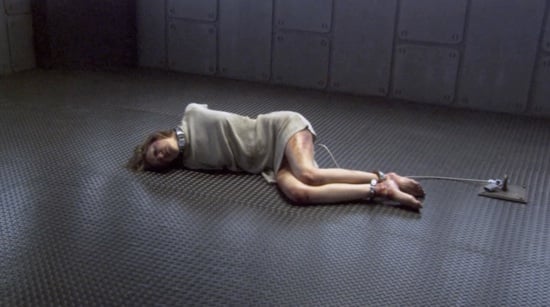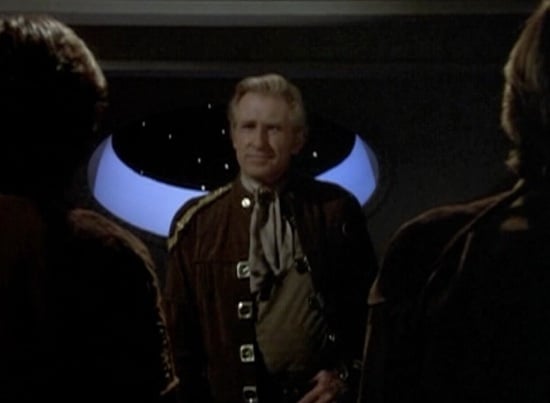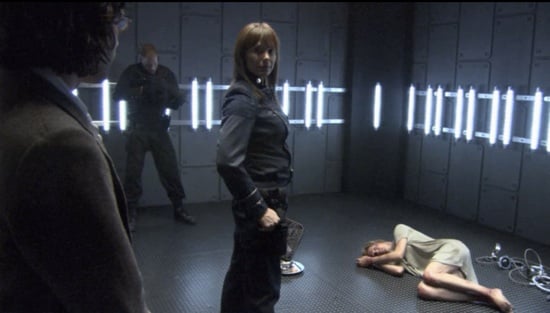Rebooting Museums (2)
By:
May 17, 2011

Second in a series of posts using the rebooted Battlestar Galactica franchise as a lens through which to view museums’ challenge to reinvent themselves. (Series intro here.)
“All this has happened before and will happen again,” the mythic, original hybrid cylon states during the BSG “Razor” miniseries. We learn later in the series that he’s speaking of the cyclical war between the human and cylon races, but the same could be said for both many of the difficult ethical, political issues that the series faces and for the series itself. The series presents its own context to a difficult cylon-torture subplot, and — within their rethinking of an iconic character, first introduced in the original series, involved in that subplot — gives us additional food for thought.
The idea of creating historic parallels between past occurrences and relatively recent events is not unusual in museological practice. In his Guardian article, “I see why ‘double genocide’ is a term Lithuanians want. But it appalls me,” Jonathan Freedland writes of the problematic approach of combined explication of Nazi and communist genocide within Lithuanian institutions. The US Holocaust Museum both features information on current world events through its Genocide Prevention Mapping Initiative and grounds the word in its historic first legal use in the 1948 trials; the institution encourages both on-site and website visitors to “Take Action” to pledge to prevent genocide from happening yet again. The National Underground Railroad Freedom Center features content on “slavery today.”
However, few things I’ve experienced have presented such a nuanced, complicated picture of recent issues as the torture subplot presented in BSG. And, after President Obama’s recent justice language-laden announcement of the death of Osama Bin Laden, I realized that the conversation within BSG wasn’t just about the ethics and politics of torture during a time of war; it’s also a question of the nature of heroism and how it’s portrayed in our culture. We have used historic parallels within our institutions; I believe that BSG’s example encourages us to not only juxtapose historic events to current events, but to also place our collections’ examples against each other to find the thematic strengths within themselves. The question of a culture’s view of heroism, for the BSG example, is a strong undercurrent that comes through.

The BSG cylon-torture subplot begins with the appearance of a second battleship — the Battleship Pegasus — and its commander, Admiral Cain. In order to see how Cain is a leader for 2005, let’s look back to her 1978 counterpart, Commander Cain. Similar to the later version, Cain appears in the original Battlestar Galactica series as the head of the Pegasus, a ship that similarly miraculously survived the initial attack and has been actively pursuing cylons in battle ever since. Cain, as played by Lloyd Bridges, is a swashbuckling maverick, respected as one of the best strategic commanders of the former colonial fleet. His own personal subplot regards whether or not his fighter pilot daughter can handle his relationship with a woman nearly as young as herself, and his most morally complicated gesture involves blowing up a cylon oil tanker to keep Galactica on the attack during the war. Though the Vietnam War — technically ended in 1975 — was morally complicated, the culture’s manifestation of its military leaders — at least in this case — may have been articulated as John Wayne via Playboy.
In his 2008 book Torture Team, tracing the legal justifications for Abu Ghraib and Guanatanamo Bay, Philippe Sands reminds us that the Gitmo and Abu Ghraib tortures have occurred in the time of (the television series 24’s) Jack Bauer — American heroism has shifted from a (Battlestar Galactica) cultural era of cowboys riding into town in order to restore order to the use of traumatic events as the justifications of individual, malicious conduct.

Similarly, the Admiral Cain of 2005’s BSG is in many ways a different beast. She’s portrayed as everything from a stern, good humoured commander to a cold-hearted leader who orders the death of civilians and torture of prisoners. Nothing is more important to her than “her ship, her crew, and her mission,” Colonel Fisk states in her memorial in Season 2, Episode 12, and she repeatedly insists that her decisions are made to protect their best interests. In the “Razor” miniseries, she orders the interrogators to use all means necessary, including pain, degredation, fear, and shame to attempt to break the cylon prisoner’s will; her perspective on cylon prisoner treatment echoes (and results in) the worst stories of Gitmo and Abu Ghraib. Her character’s general demeanor could be modeled after the vision of US General Stanley McChrystal, a man recounted in the 2010 Rolling Stone profile “The Runaway General” as disciplined enough to barely eat or sleep. She is likely too moral to cross the lines of the recent profile of Gen. William Caldwell — a General accused of using psy-ops on US Senators to keep support for the war alive, but she is ruthless enough to kill her own Executive Officer (with his own gun, in front of the rest of the crew) when her orders are not obeyed. Her world is more complicated than that presented in the 1978 series, and her decisions are fraught with complications as well.

The BSG subplot is clearly an homage to the original subplot, from the similar details of their ships’ initial appearances down to the duplicative nature of particular attack moves used against the cylons in battle. However, In the 1978 series, Commander Cain rides off into the military sunset; in 2005, Admiral Cain is shot by her escaped, tortured cylon captive. The world (and our imagination of our heroes), even in the re-imagining of BSG, has changed.
The “Razor” miniseries appeared in 2007, though the original subplot on Cain aired in 2005. It serves as both a prologue and postscript to what we as viewers have seen, beginning with the
revelation of the torture and ending with Cain’s death, in the earlier episodes. After the death of both Cain and her protégé (through whom we learn the history of Cain’s decisions and are given glimpses into the humanity underlying the tough decisions a steely Cain has otherwise made), Admiral Adama speaks with his son, Commander Apollo Adama (now commanding officer of the Pegasus), about Admiral Cain’s choices. “If I believed in the gods, I’d say they’d be judged by a higher power,” the Admiral states. “But since you don’t believe?” Apollo replies. “Then history will have to make its judgments,” responds Adama, “[H]istory’s first drafts will be written in our logs.”
On May 11, 2004, days after installing a photographic exhibit in the rotunda of the Russell Senate Building that was in part about the treatment of asylum-seeking Haitian detainees in Florida (an exhibit that a recent Miami Herald article on Bruce Weber recounts as being deemed “too political” by Trent Lott and for which its included text was subsequently removed before installation), I read the Washington Post. The front page featured images of Middle Eastern detainees, and the newspaper was filled with articles responding to the breaking story of prisoner torture at Abu Ghraib. “The Psychology of Torture; Past Incidents Show Abusers Think Ends Justify the Means” by Shankar Vedantam was one of the articles I read in the Post that day. Vedantam wrote
It was a small group of military police who carried out the horrific abuses in a distant country. The torturers were not sadists, but perfectly normal people. The torturers believed their unpleasant work would save lives.
Those statements do not refer to the U.S. guards at Abu Ghraib. The first sentence describes a German battalion that methodically tortured and killed thousands of Jews during World War II. The second describes a Stanford University psychology experiment that carefully screened out abnormal people and found that normal people given extraordinary power quickly turn sadistic. The third describes torturers in the Israeli-Palestinian struggle, British officers in Northern Ireland and some police officials in Chicago.
As the first hybrid stated, “All this has happened before and will happen again.” With all the historic information we have stored away within our cultural institutions, what new insight might we provide? And how might we look past simply the details of events to contextualize our shifts in cultural understanding as well?

READ other HiLobrow series: ANGUSONICS — the solos of Angus Young | ARTIST IN RESIDENCE — HILOBROW’s favorite artists | BICYCLE KICK | THE BOOK IS A WEAPON — a gallery | CABLEGATE COMIX | CECI EST UNE PIPE — a gallery | CHESS MATCH — a gallery | DE CONDIMENTIS — a world-secret-historical take on ketchup, mustard, relish, and more | DIPLOMACY — a world-conquest boardgame musical | DOTS AND DASHES — a gallery | DOUBLE EXPOSURE — the stratagems of Middlebrow | EGGHEAD — a gallery | EPIC WINS — our versions of epic poems | FILE X — a gallery | FITTING SHOES — famous literary footwear | GOUDOU GOUDOU — adventures in Haiti | KIRB YOUR ENTHUSIASM — 25 Jack Kirby panels | LATF HIPSTER | MERIT BADGES — earn ’em! | MOULDIANA — the solos of Bob Mould | PANTENE MEME — a found gallery | PHRENOLOGY — the insane origin of browism | PLUPERFECT PDA — time-traveling smartphones! | POP ARCANA — spelunking weird culture | REBOOTING MUSEUMS | ROPE-A-DOPE — boxing | SECRET PANEL —Silver Age comics’ double entendres | SHOCKING BLOCKING — cinematic blocking | SKRULLICISM | UKULELE HEROES
